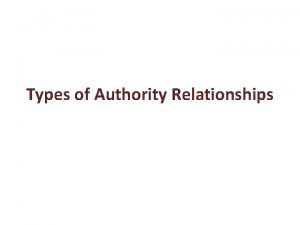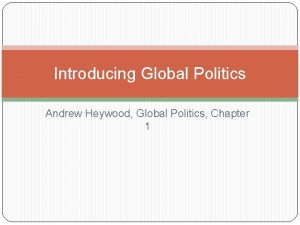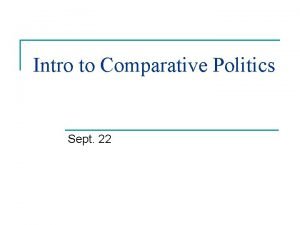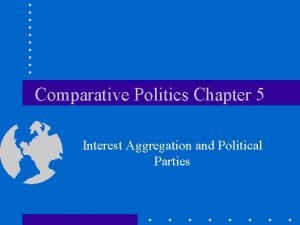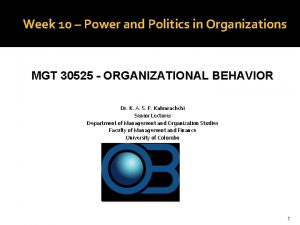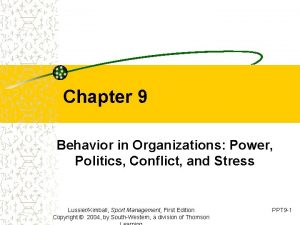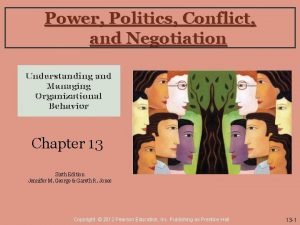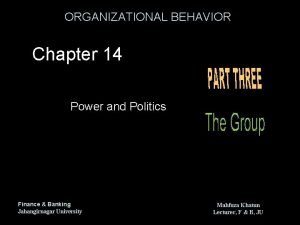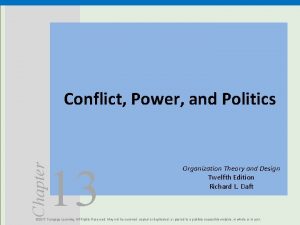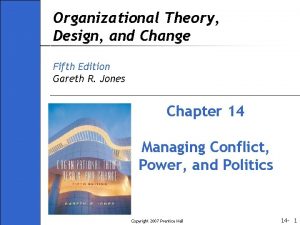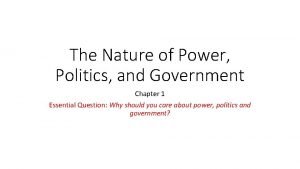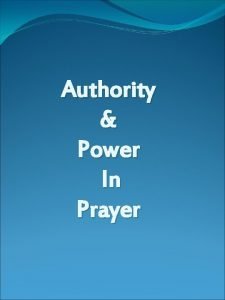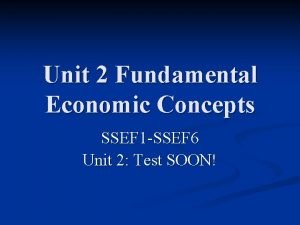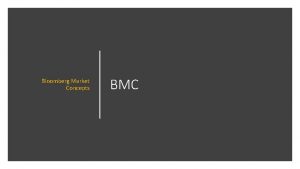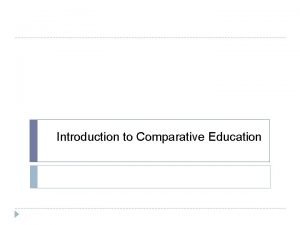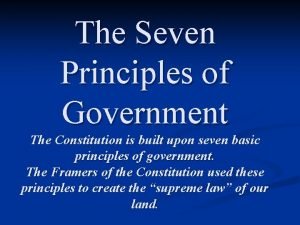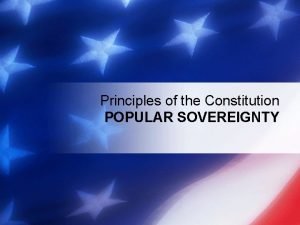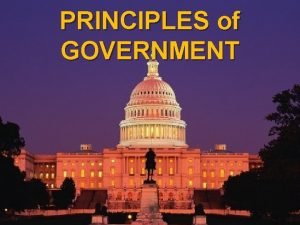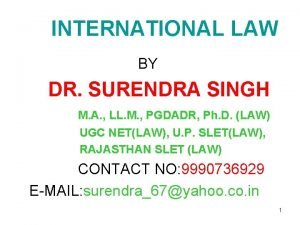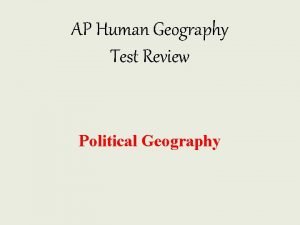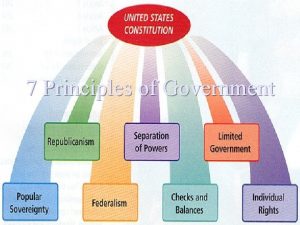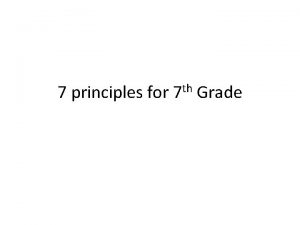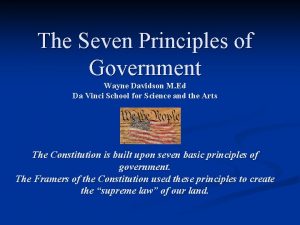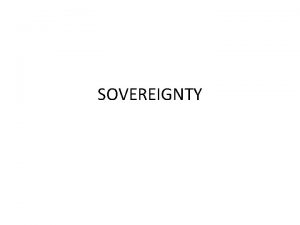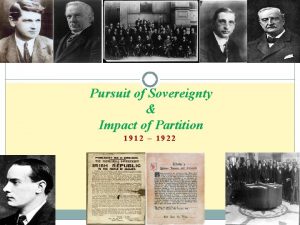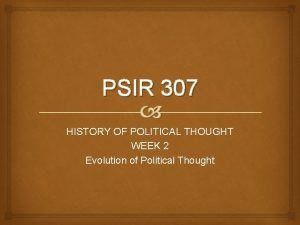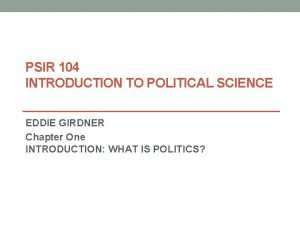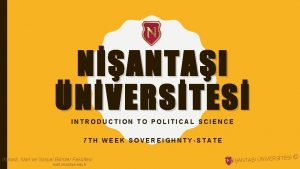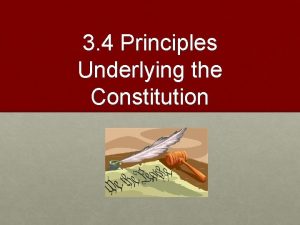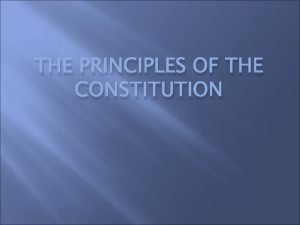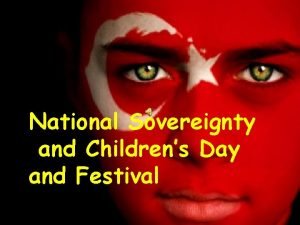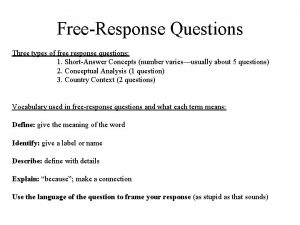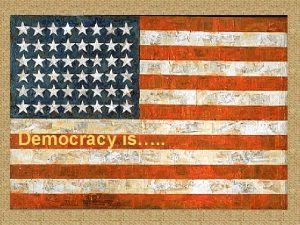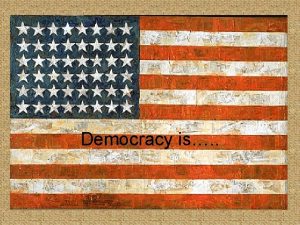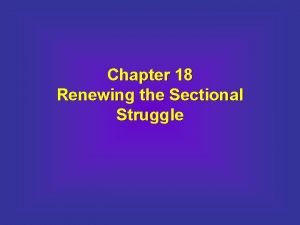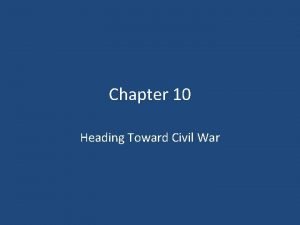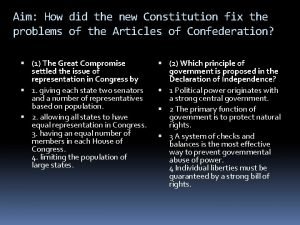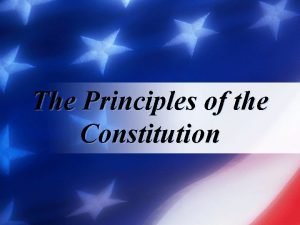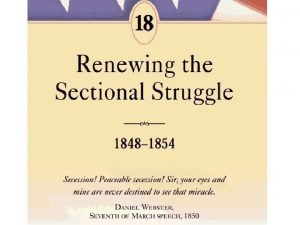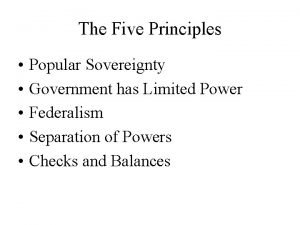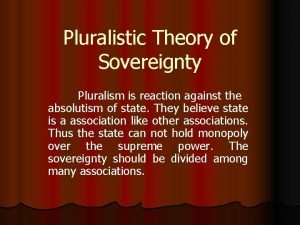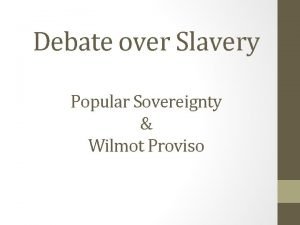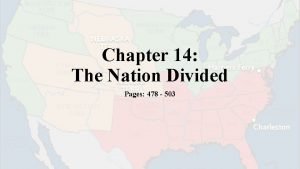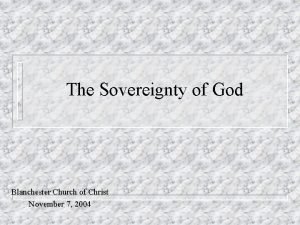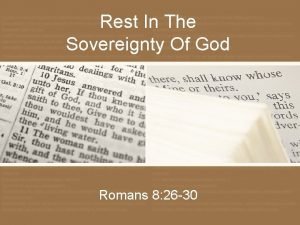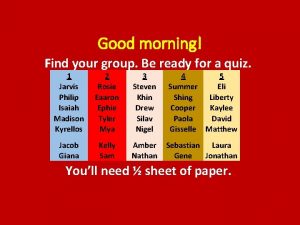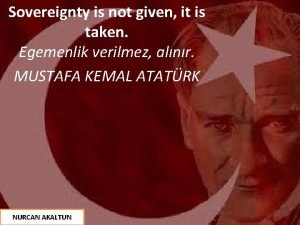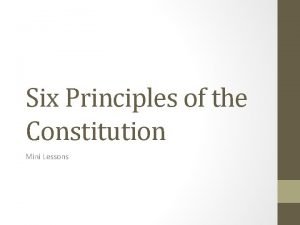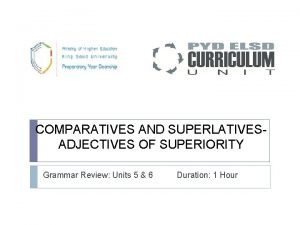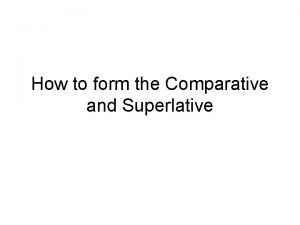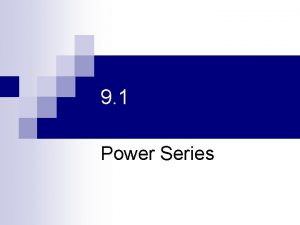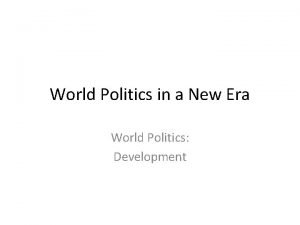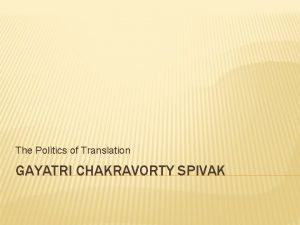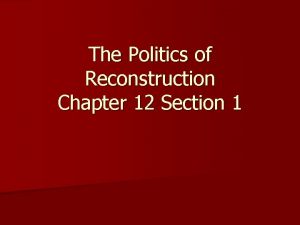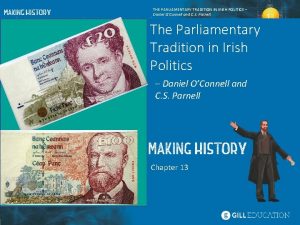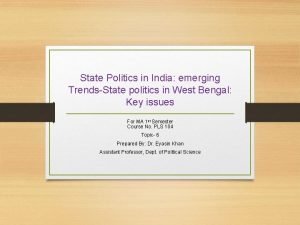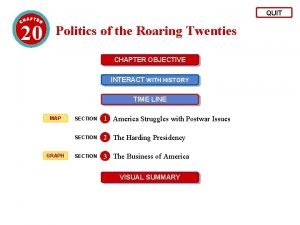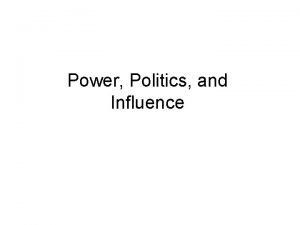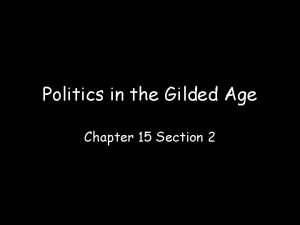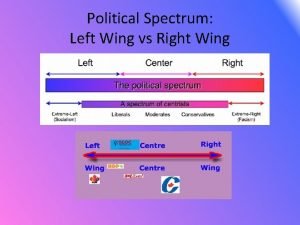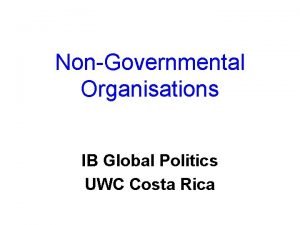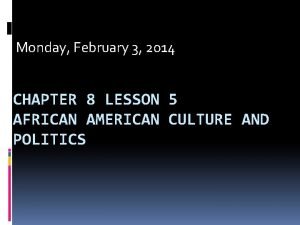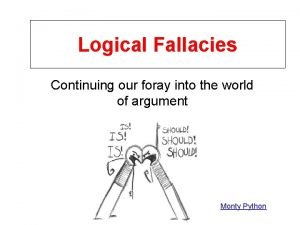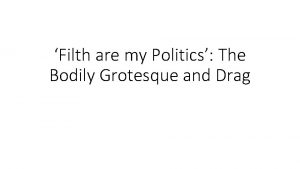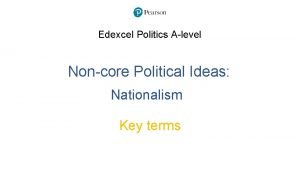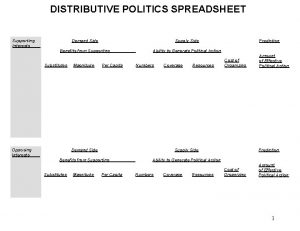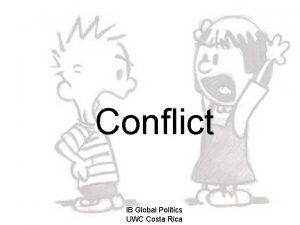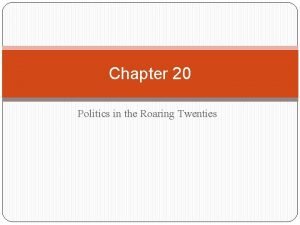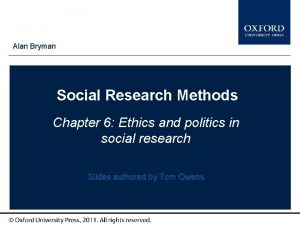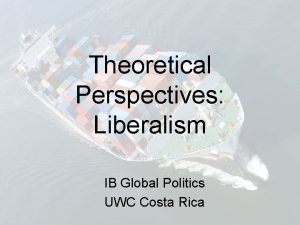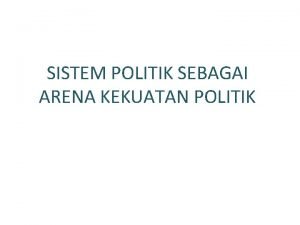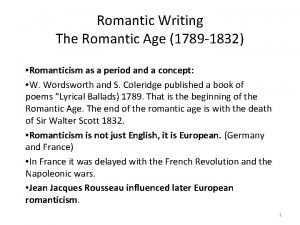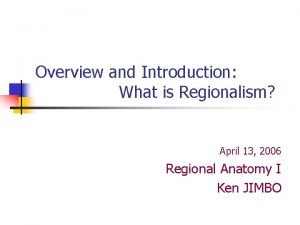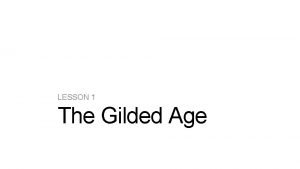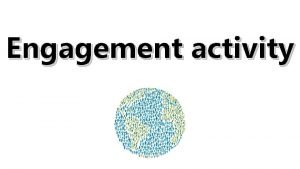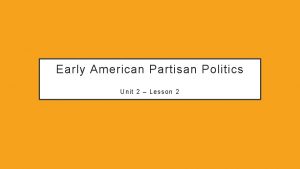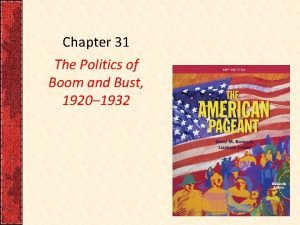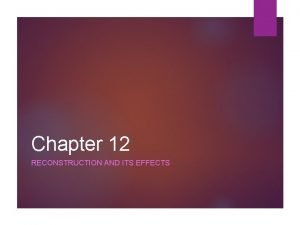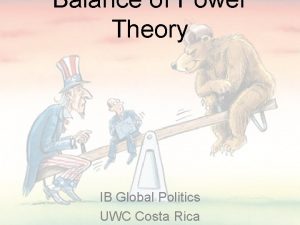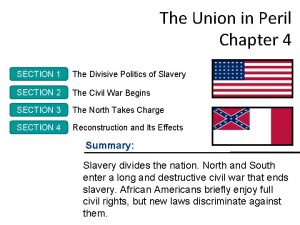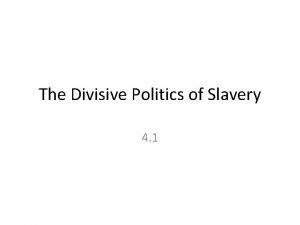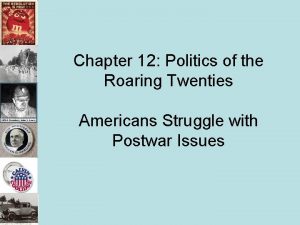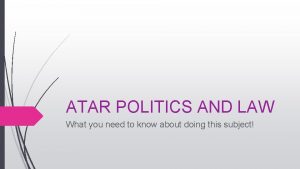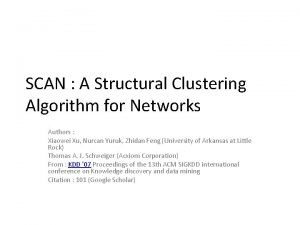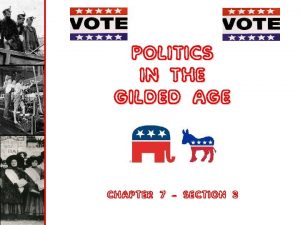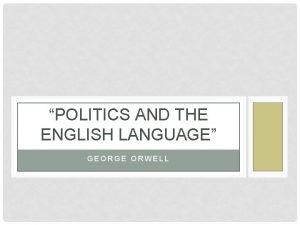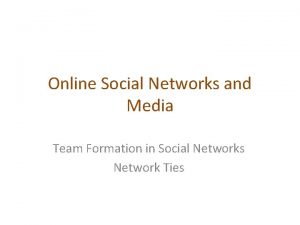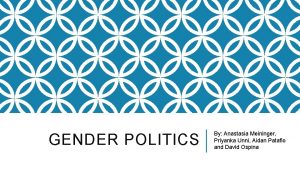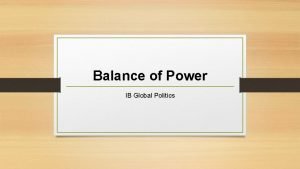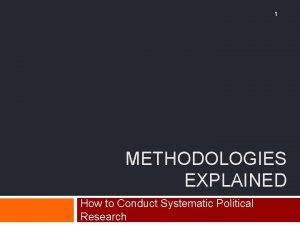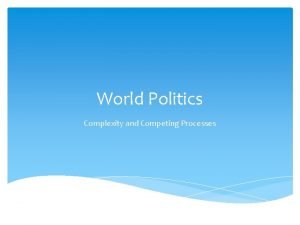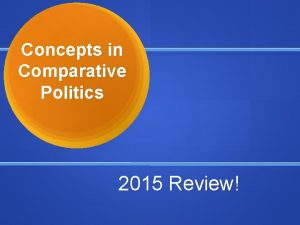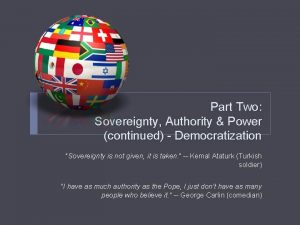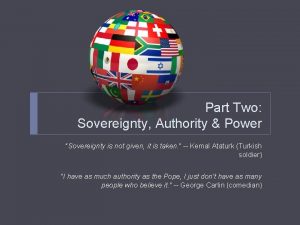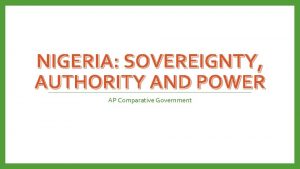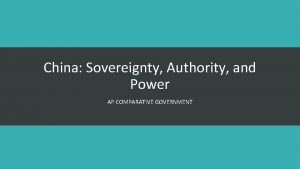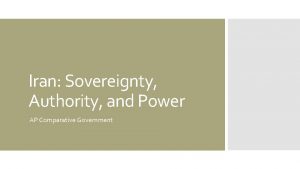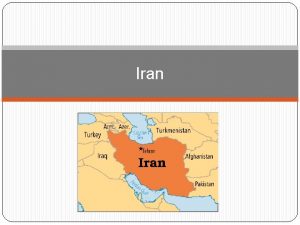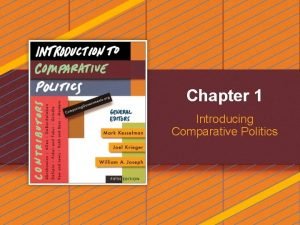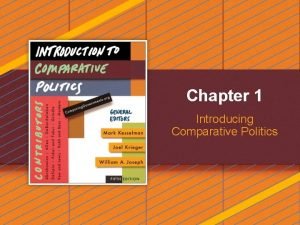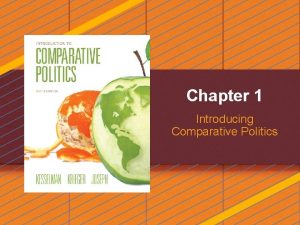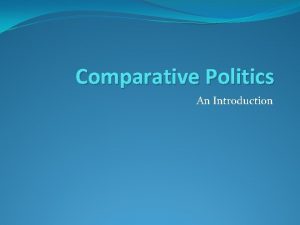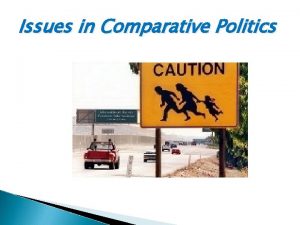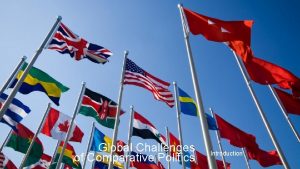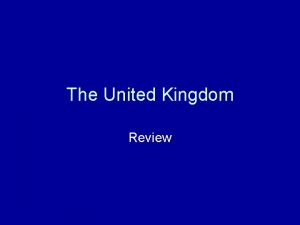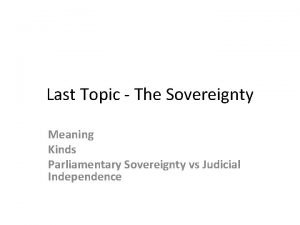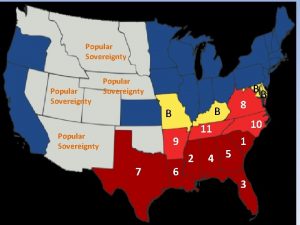Concepts in Comparative Politics Review Power Sovereignty Authority


































































































































- Slides: 130

Concepts in Comparative Politics Review!

Power, Sovereignty, & Authority Key Concepts

Power The ability to direct the behavior of others through coercion, persuasion, or leadership

Authority Legal right to exercise power on behalf of the society and/or government

Sovereignty Independent legal authority over a population in a particular place The degree in which a state can control its own territory and independently make and carry out policy

Sovereignty (cont. ) External sovereignty—means the right to make binding agreements (treaties) with other states Internal sovereignty—means the right to determine matters having to do with one’s own citizens

Nation A group of people who identify themselves as belonging together because of cultural, geographic, or linguistic ties. Nations need not, and often do not have, sovereignty in order to exist

State A political system that has sovereignty (political power) exercised over a population in a defined geographic territory through a set of public institutions

Nation-State An independent state that exists for a single nation, it is the ultimate goal of most nationalists The cases in which national identification and sovereign political authority largely coincide

Regime A political system with a specific pattern of relationship between the state, society, markets, and the world at large A pattern of organization for a government (often described in a constitution or supreme law)

Types of Regimes

Democracy A system of government by the whole population or all the eligible members of a state, typically through elected representatives Refers to a political system in which citizens enjoy basic rights and in which leaders are elected in free and fair elections and accountable under the rule of law

Substantive/Liberal Democracy Competitive Elections Civil liberties Rule of law Neutrality of the judiciary Open civil society Civilian control of the military

Democratic Deficit A democratic deficit occurs when ostensibly democratic organizations or institutions in fact fall short of fulfilling what are believed to be the principles of democracy

Illiberal Democracy A procedural democratic regime where the citizenry does not benefit from the full array of rights and freedoms that one would expect in a democracy Example: competitive elections but lack of civil liberties and rights

Authoritarian Rule A system of rule in which power depends not on popular legitimacy but on the coercive force of the political authorities

Oligarchy A system of governance dominated by a small powerful and wealthy group in a state Rule by few Important political rights are withheld from the majority of the population Example: South Africa during apartheid

Military Rule Military control of the government by armed forces

Totalitarian Systems A political system in which the state attempts to exercise total control over all aspects of public and private life, including, the economy, culture, education, and social organizations, through an integrated system of ideological, economic and political control Usually rely on terror as a means to exercise power

Totalitarian Systems (cont. ) Government systems in which the government constricts rights and privacy of its citizens in a severe manner Most authoritarian and totalitarian regimes have lost legitimacy today

Theocracy A state dominated by the clergy, who rule on the grounds that they are the only interpreters of God’s will and law

Government The part of the state with legitimate public authority The group of people and organizations that hold political authority in a state at any one time

Legitimacy Defined as citizens belief in the government’s right to rule IT IS THE VIEW OF THE GOVERNMENT FROM THE BOTTOM UP!—THE PEOPLE’S VIEW OF THEIR GOVERNMENT A belief that a regime is a proper one and that the government has the right to exercise power In the contemporary world, a state is said to possess legitimacy when it enjoys consent of the governed, which usually involves democratic procedures and the attempt to evenly distribute resources Legitimacy of the political system also provides foundation for a successful political process Legitimacy is based on different things in different countries

Rational-Legal Legitimacy based on well-established laws and procedures Code Law: based on written rules/codes of law (China, Mexico, Russia) Common Law: based on tradition, past practices, and legal precedents (Britain)

Constitution A supreme law that defines the structure of a nation-state’s regime and the legal processes governments must follow When followed, this establishes rule of law Needn’t be one document Contains a set of decision rules

Rule of Law A governance system operating predictably under a known and transparent set of procedural rules (laws) Also know as, constitutionalism In all disputes, no matter how important or influential the person is, “the piece of paper wins!”

Charismatic Legitimacy A form of authority based on the general population’s personal attachment to a particular leader

Political Structures & Institutions Key Concepts

Supranational Organizations in which nations are not totally sovereign actors Examples: NATO European Union NAFTA OPEC United Nations

Three Basic Geographic Distributions of Power 1. Unitary System 2. Confederal System 3. Federal System The difference between the three has to do with how power is distributed over a geographic area

Unitary State Concentration of political power in a central government as opposed to federalism EX: The United Kingdom, Iran, China

Devolution A process in a unitary system of delegating some decision making to local public bodies The UK is doing this with Scotland Wales. This is also a sign of fragmentation Usually done to reverse or quell separatist movements Could be described as moving from a unitary system to a federal system

Confederal System A system of government that spreads power among many subunits (such as states), and has a weak central government Ex: European Union

Federal System A system of governance in which political authority is shared between the national government and regional or state governments EX: The United States, Mexico, Nigeria, Russia (Asymmetric)

How Devolution Differs From Federalism: Power can be taken away in a unitary system (by the central government) Subnational government’s powers are not constitutionally protected In a unitary system decentralization is not necessarily symmetrical Local legislature/government can be dissolved in unitary systems but not in federal systems

Three Basic Forms of Governments 1. Parliamentary System 2. Presidential System 3. Mixed Presidential-Parliamentary System The difference between the three has to do with the origins of power and the relationship between the executive branch and the other branches of government

Parliamentary System A system of governance in which the head of government is chosen by and serves at the pleasure of the legislature The legislature rules over all! Prime Minister is NOT directly elected by people , but by the legislature Because the prime minister and the cabinet are also leaders of the majority party in the legislature, no separation of powers exists between executive and legislative branches—instead they are fused together Fusion of Power! Executive power is separated between Head of Government (PM) and the Head of State (royalty, president)

Parliamentary System Characteristics: High Party Discipline Majority party almost always gets its policies implemented Cabinet is VERY powerful—initiates legislation and makes policy No fixed terms of office—PM must call for election or as the result of a vote of no confidence

Fusion of Powers A system of governance in which authority of government is concentrated in one body The executive branch is born of the legislative branch of government In Britain, Parliament is the supreme legislative, executive, and judicial authority Common pattern in parliamentary systems

Vote of Confidence A vote in parliament expressing support for a government A government losing a vote of confidence is often expected to resign

Presidential System An electoral system where citizens vote for legislative representatives as well as for executive branch leaders, and two branches function with separation of powers The chief executive is elected in a national ballot and is independent of the legislative branch The roles of the head of state and head of government are given to one person—the president Three branches of government are therefore separate from one another and can check each other’s power

Presidential System Characteristics: Separation of Power shared equally between legislature and executive Lower party discipline Have fixed terms Since power is diffused, policymaking process is slowed because one branch may question decision made by other groups

Separation of Power An organization of political institutions within the state in which the executive, legislature, and judiciary have autonomous powers and no branch dominates the others Common pattern in presidential systems

Checks and Balances A governmental system of divided authority in which coequal branches can restrain each other’s actions

Impeachment The process provided legislatures in most presidential systems that provides for the removal of presidents before their term is up, but typically only if they are guilty of serious criminal or other wrong doing

Mixed Presidential Parliamentary System A democracy that has some characteristics of a presidential system and some characteristics of a parliamentary system Also referred to as semi-presidential System where a prime minister coexists with a president who is directly elected by the people and who holds a significant degree of power Russia is perfect example of powerful president

Institutions In order to carry out public policies, government structures such as parliaments, bureaucracies, and administrative agencies perform functions, which in turn enable the government to formulate, implement, and enforce policies There are many types of institutions: parliaments, congresses, administrative agencies, political parties, interest groups, legislatures

Key Parts of All Governments 1. Executive 2. Legislature 3. Judiciary 4. Bureaucracy All of AP 6 countries have these structures, how they function varies greatly

Executive The executive office carries out the laws and policies of the state The chief executive is the most important person in the policymaking process, initiating new policies and playing an important role in their adoption Presidential system has veto power, in parliamentary system does not Central authority on in foreign policy

Head of State The head of state is a role that symbolizes the and represents the people, both nationally and internationally, and may or may not have any real policy making power The chief public representative of a state Commonly royalty or a president KEY POINT: In presidential systems the president is both the head of government and the head of state

Head of Government The office and the person occupying the office charged with leading the operation of a government The head of government deals with the everyday tasks of running the state and usually directs the activities of other members of the executive branch In Britain, the Queen is Head of State and the Prime Minister is the Head of Government In the U. S. , the president is both head of government an head of state

Cabinet Refers to the group of leaders (often called “ministers” or “secretaries”) of all major departments (sometimes called “ministries”) into which the executive branch is divided The cabinet is the most important decision-making body in most political systems In parliamentary systems the cabinet is the key organization that forms policy proposals The cabinet in parliamentary systems is typically selected by the head of government & can be dismissed when a government loses a vote of confidence In presidential systems, the cabinet is selected by and can be dismissed by the president

Legislature The legislative is the branch of government charged with making laws Either bicameral or unicameral

Bicameral Legislature A legislature with two houses with decision making power Most common form of legislature Usually there is an “upper” and “lower” house Found almost always in federal systems EX: UK (House of Lords & House of Commons); Russia (Federation Council & Duma); Mexico (Senate & Chamber of Deputies); Nigeria (Senate & House of Reps)

Unicameral Legislature A legislature with only one house with decision making power Examples: China (The National People’s Congress), Iran (Majles)

Judicial Review The power of the judiciary to rule on whether laws and government policies are consistent with the constitution or existing laws

Bureaucracy Bureaucracies consist of agencies that generally implement government policy In democracies provide continuity over time In authoritarian regimes, head of gov’t exercises control; patronage system Because of the complexity of legislation, bureaucracies often play a quasi legislative role in making policy Bureaucrats are the experts in their field

Bureaucracy Basic characteristics of: Non-elected positions—appointed Impersonal, efficient structures, but become inefficient as they grow Formal qualifications for jobs necessary Hierarchical organization

Civil Service A system of carefully describing tasks involved in performing government jobs, evaluating applicants for those jobs (civil service exams), and hiring people from among those applicants based on skills and experience rather than political factors These are bureaucrats (internally) and diplomats (externally)

Electoral Systems & Party Systems Key Concepts

Electoral System A legal system for making democratic choices Create two-party, three-party, multiparty systems Rules by which elections are conducted Determine who can vote, how people vote, and how the votes get counted Two Main Kinds of Systems 1. Competitive 1. 2. Single Member District Plurality (SMDP) and (First-Past-the-Post) Proportional Representation (PR) 2. Authoritarian

Plurality The number of votes cast for a candidate who receives more than any other candidate but does not receive an absolute majority “More than anyone else, but under 50%. ”

Single Member District Plurality An electoral system in which candidates run for a single seat from a specific geographic districts An electoral system in which voters chose an individual running for office in a single legislative district (also called “first past the post“) *Example: U. K. and United States The winner is the person who receives the MOST votes, whether or NOT that is a majority Increase the likelihood of a two-party state Common in the United States, rarely used in continental Europe or in Latin America A variation on this is the majority runoff system (or double ballot)

First-Past-the-Post An electoral system in which winners are determined by which candidate receives the largest number of votes (regardless of whether or not a majority is received) SAME as Single Member District Plurality!

Two (Double) Ballot System An electoral system where two rounds of voting may take places to ensure a majority winner Several candidates my be on first ballot, if no majority is chose, second ballot is run-off of top two vote getters Also called the majority runoff system

Proportional Representation (PR) An electoral system in which voters select parties rather than individual candidates and parties are represented in legislatures in proportion to the shares of votes they win Representatives are elected based on the proportion of the electorate that voted for them Encourages a multi-party system Closed-list PR system: voters don’t know people chosen by party Open-list PR System: voters chose from list of candidates given by parties

Proportional Representation (PR) How Proportional Representation system works: A country is divided into a few large sections The competing parties offer lists of candidates The number of legislative representatives a party wins depends on the overall proportion of the votes it receives Sometimes parties must meet a minimum threshold of votes in order to receive any seats at all (5% or 7%) KEY POINT: PR system leads to multiparty legislatures (Exception: Russia’s raising of threshold to 7% has resulted in less representation of regional parties)

Minimum Winning Threshold The minimum percentage of votes a party must receive in order to be seated in a legislature Sometimes parties must meet a minimum threshold of votes in order to receive any seats at all (5% or 7%)

Duverger’s Law Maurice Duverger: French political scientist States that there is a systematic relationship between electoral systems and party systems, so that singlemember district plurality (SMDP) election systems (“first past the post”) tend to create two-party systems in the legislature, while proportional representation (PR) electoral systems generate multiparty systems SMDP (first past the post) = Two Party System Proportional Representation = Multiparty System

Duverger’s Law Mechanical Effect: In SMDP systems, second and third place finishers in each district get NO representation in legislature Psychological Effect: In SMDP, people don’t want to vote for a known loser, so they chose their second or third choice, so as to block their worst case scenario Strategic Voting: The act of voting for your second or third preference to avoid an even worse case scenario Example: Voting Democrat instead of Green, so as to avoid Republicans gaining seats in legislature (Strategic voting)

Competitive Party Systems Political systems in which parties can form and compete freely The role of competitive parties in interest aggregation depends on the type of party system Interest aggregation in a competitive party system occurs in several stages Parties develop positions that they believe are backed by a large block of voters In a two party system, it is important for a party to win the majority, so targeting the center of the electorate is often necessary to win enough votes. In systems with many parties, each party seeks a distinctive and cohesive electoral base, meaning that party policies may reflect the preferences of specific groups

Multiparty System A party system with several important political parties, none of which generally gains a majority of the seats in the national Mexico, Nigeria

Two-Party System A party system in which two main parties compete for majority control of the government Small parties may exist but play no significant role in national electoral outcomes UK

One-Party Dominant System A party system in which one large party directs the political system, but small parties exist and may compete in elections Russia (& Mexico in the past under the PRI)

One-Party System A party system in which one political party controls the government and voters have no option to choose an opposition party (China)

Elite Recruitment Refers to the selection of people for political activity and government offices In a democracy, competitive elections play a major role in political recruitment In authoritarian systems, recruitment may be dominated by a single party, as in China, or unelected religious leaders, as in Iran

Referendum A general vote by the electorate on a single political question that has been referred to them for a direct decision

Interest Articulation The methods by which citizens and groups can express their desires and make demands upon government (political participation, lobbying, protests, etc. ) Involves individuals and groups expressing their needs and demands

Interest Aggregation Ways in which demands of citizens and groups are combined into proposed policy packages (leadership, political parties, etc)

Interest Articulation The most common form is voting in an election— found in democracies and totalitarian regimes Other forms of interest articulation: community groups, political groups, protests, any from of group which articulates its opinion to the government In large, established political systems, formal interest groups are a primary means of articulating political interests As societies become more complex and scope of government grows, quantity and methods to articulate public interests have grown as well

Pluralist Interest Group Systems Multiple groups may represent a single society interest. There is a clear separation between interest groups and the government Group membership is voluntary and limited Groups often have a loose or decentralized organizational structure United States is perfect example

Corporatism A state in which interest groups become an institutional part of the political structure HAS NOTHING TO DO WITH BUSINESS! ZERO! GET THAT OUT OF YOUR MIND!

Neo-Corporatist Interest Group Systems A single peak association normally represents each societal interest Membership in the peak association is often compulsory and nearly universal Peak associations are centrally organized and direct the actions of their members Interest groups are often systematically involved in making and implementing policy Key Point: Interest group part of policy process!

Controlled Interest Group Systems There is a single group for each social sector Membership is often compulsory Each group is normally hierarchically organized Groups are controlled by the government or its agents in order to mobilize support for government policy (Communism!) Key Point: Groups exist to facilitate government control of society!

Patron/Client Networks A usually informal alliance between a person holding power and less powerful or lower status people The powerful patron provides power, status, jobs, land, goods, and/or protection in exchange for loyalty and political support Also: Clientelism, Prebendalism

Citizens, Society, & the State Key Concepts

Ethnicity Refers to a group who share a belief in their common descent and common shared traditions Ethnic groups have been the source of a large number of political conflicts around the world Language can be a source of social division that may or may not be associated with ethnicity

Political Cleavages Factors that separate groups within a society May be based on ethnicity, religion, social class, region, etc The wider and deeper the cleavages, the less unified the society Coinciding Cleavages: cleavages which reinforce each other (pit the same people against each other on many different issues) Cross-cutting Cleavages: when the groups that are divided share a common interest on one or more issues

Political Culture The collection of history, values, beliefs, assumptions, attitudes, traditions, and symbols that define and influence political behavior within a state The more a political culture is shared, the easier it is to live in peaceful coexistence and engage in activities for mutual gain, such as commerce

Consensual Political Culture Citizens tend to agree on the appropriate means of making political decisions and to agree on the major problems facing society and how to solve them

Conflictual Political Culture The citizens are sharply divided, often on both the legitimacy of the regime and solutions to major problems When a country is deeply divided in political attitudes, distinctive political subcultures may develop.

Political Efficacy Political efficacy is a citizen’s belief that he or she can understand influence government or political affairs It indicates a citizens' faith and trust in government and their own belief that they can understand influence political affairs

Transparency Transparent government operates openly More transparent, less corruption

Social Capital Refers to skills, norms, and networks that are a part of civil society and facilitate the ability to solve economic and political problems

Political Socialization How citizens learn about politics in their country – it sticks!! Involves schools, families, communications, media, religious organizations, and all the various political structures that develop, reinforce, and transform the political culture, the attitudes of political significance in the society

Political Protest Can also focus political interests and can have influence on public policy Tend to be high-pressure activities that can both mobilize the public and pressure political elites Grassroots politics, or people working together to address a common problem, represents an other

Civil Society Is a society in which people are involved in social and political interactions free of state control or regulation Refers to the space occupied by voluntary associations outside of state control THE GOVERNMENT DECIDES! NOT THE CITIZENS! For example, professional associations, trade unions, student groups, women’s groups, religious bodies and other voluntary association groups

Civil Society Any type of citizen-organized group is considered to be a part of civil society This includes community groups, voluntary organizations, and religious groups It could also include a group that is not so civil, like an anti-government group. Civil society is linked to globalization, as groups connect to other groups in the global community, such as groups within the environmental movement

Non-Governmental Organizations (NGOs) Global civil society Examples: Doctors Without Borders, Amnesty International, Red Cross

Post Materialist Values Beliefs in the importance of policy goals beyond one’s immediate self-interest, as well as one’s prosperity and security Examples: Environmentalism and cultural diversity Citizens in industrialized democracies are more likely to have “higher order” concerns, such as improving education and the environment Another major trend in political culture

Political & Economic Change Key Concepts

Reform Method of changing some of the methods that political/economic leaders use to reach goals that society generally accepts Does not advocate overthrowing basic institutions

Revolution A process by which a political regime is overthrown and replaced because of a broad popular support and participation in the process A forcible overthrow of a government or social order for a new system

Coup D’etat A forceful replacement of a regime or a government by a small elite group or groups Use of force, often by military

Democratization The spread of representative governments to more countries and the process of making governments more representative

Political Liberalization Process by which a state goes from procedural democracy to substantive democracy

Market Economy in which laws of supply and demand determine allocation of resources Private ownership of resources/property

Command Economy in which the state owns most economic resources and makes all major economic decisions

Economic Liberalization Process of limiting the power of the state over private property and market forces

Privatization Transfer of state-owned property to private ownership

Neoliberalism Term used to describe government policies aiming to promote free competition among business firms within the market Includes privatization, reducing trade barriers, balancing government budgets, and reducing social spending

Import Substitution Industrialization Employs high tariffs to protect locally produced goods from foreign competition, govt ownership of key industries, govt subsidies to domestic industries

Structural Adjustment Programs World Bank programs which offer financial and management aid to poor countries while demanding privatization, trade liberalization, and governmental fiscal restraint

Globalization The increasing interconnectedness and interdependence of people, cultures, economies, and nationstates facilitated by technology, trade, and cultural diffusion

Fragmentation The process or state of breaking or being broken into small or separate parts

Modernization The major cultural trend that has transformed the world is modernization World wide more people are moving to cities and are exposed to modern political cultures, which have an impact on citizens’ attitudes

Modernization Theory The view that a country’s move from underdevelopment to modernization can be understood from and modeled after development in the West

Public Policy Key Concepts

Policymaking is the conversion of social interest and demands into authoritative public decisions Rules usually set by constitution

Policy Implementation The carrying out and enforcement of public policies

Rentier State A country that obtains much of its revenue from the export of oil or other natural resources Impact: Government doesn’t have to be accountable to citizens for income

Rent-seeking The practice of political leaders who, for the purposes of remaining in a position of power, “rent” public access (resources or tax support services) to patrons who profit from those public assets

Economic Indicators

GDP Gross Domestic Product All the goods and services produced by a country’s economy in a given year, excluding income earned outside country

GNP Gross National Product GNP is the total economic output of a country person Like GDP, but also includes income citizens earned outside the country Used to compare the economic status of a country

Purchasing Power Parity (PPP) A different measure of the economic status of a country, and it takes into account differences in price levels from one country to another

GINI Index Measures the amount of economic inequality in a society

Human Development Index (HDI) Measures the well-being of a country’s people by factoring in adult literacy, life expectancy, educational enrollment and GDP

Welfare State A state which provides a wide array of social services to its members

Freedom House Measures political rights & civil liberties Free, Partly Free, Not Free
 Line authority adalah
Line authority adalah Comparative theories politics a level
Comparative theories politics a level Global politics by andrew heywood
Global politics by andrew heywood Political comparative and superlative
Political comparative and superlative Interest aggregation in comparative politics
Interest aggregation in comparative politics Power and politics in organizations
Power and politics in organizations The power of politics
The power of politics Power, politics and conflict in organizations
Power, politics and conflict in organizations Power, politics and conflict in organizations
Power, politics and conflict in organizations Contrasting leadership and power
Contrasting leadership and power Power and politics organization theory
Power and politics organization theory Power and politics
Power and politics The nature of power politics and government
The nature of power politics and government Triangle of power
Triangle of power Difference between authority and responsibility
Difference between authority and responsibility Prayer points for power and authority
Prayer points for power and authority Difference between authority and power
Difference between authority and power Unit 1 review fundamental economic concepts answers
Unit 1 review fundamental economic concepts answers Bloomberg bmc solutions
Bloomberg bmc solutions What is the scope of comparative education
What is the scope of comparative education Definiton of popular sovereignty
Definiton of popular sovereignty The principle of state sovereignty
The principle of state sovereignty Constitution popular sovereignty
Constitution popular sovereignty Popular sovereignty examples
Popular sovereignty examples De jure and de facto sovereignty
De jure and de facto sovereignty Popular sovereignty songs
Popular sovereignty songs Buffer state ap human geography
Buffer state ap human geography What are the 7 principles of government
What are the 7 principles of government Popular sovereignty definition
Popular sovereignty definition Popular sovereignty definiton
Popular sovereignty definiton External sovereignty
External sovereignty Superanus
Superanus Pursuit of sovereignty and impact of partition essays
Pursuit of sovereignty and impact of partition essays Internal and external sovereignty
Internal and external sovereignty Branches of political science
Branches of political science Limitations of parliamentary sovereignty uk
Limitations of parliamentary sovereignty uk External sovereignty
External sovereignty Limerick poem creator
Limerick poem creator Popular sovereignty
Popular sovereignty Popular sovereignty
Popular sovereignty Popular sovereignty
Popular sovereignty National sovereignty and childrens day
National sovereignty and childrens day Define sovereignty
Define sovereignty Title
Title Direct democracy political cartoon
Direct democracy political cartoon Popular sovereignty
Popular sovereignty Popular sovereignty
Popular sovereignty Whats popular sovereignty
Whats popular sovereignty Popular sovereignty
Popular sovereignty Popular sovereignty
Popular sovereignty Popular sovereignty
Popular sovereignty Popular sovereignty
Popular sovereignty Popular sovereignty
Popular sovereignty The constitution spells out the powers denied to
The constitution spells out the powers denied to Pluralistic theory of sovereignty
Pluralistic theory of sovereignty Popular sovereignty
Popular sovereignty 503 divided by 3
503 divided by 3 God's sovereignty
God's sovereignty Internal sovereignty
Internal sovereignty What is the message
What is the message Sovereignty is not given it is taken
Sovereignty is not given it is taken Popular sovereignty
Popular sovereignty Food sovereignty
Food sovereignty Chapter review motion part a vocabulary review answer key
Chapter review motion part a vocabulary review answer key Writ of certiorari ap gov example
Writ of certiorari ap gov example Nader amin-salehi
Nader amin-salehi Prisma diagram example
Prisma diagram example Narrative review vs systematic review
Narrative review vs systematic review Adjectives
Adjectives Comparative and superlative of tall
Comparative and superlative of tall Causal-comparative/quasi-experimental,
Causal-comparative/quasi-experimental, World power era eoc blitz review
World power era eoc blitz review Differentiate power series
Differentiate power series World politics in a new era
World politics in a new era Spivak the politics of translation
Spivak the politics of translation Chapter 12 section 1 the politics of reconstruction
Chapter 12 section 1 the politics of reconstruction What does parliamentary tradition mean
What does parliamentary tradition mean Explain emerging patterns of state politics in india
Explain emerging patterns of state politics in india Politics of the roaring twenties
Politics of the roaring twenties A key part of backstabbing as a political tactic is to
A key part of backstabbing as a political tactic is to Factors contributing to organizational politics
Factors contributing to organizational politics Pendleton civil service act
Pendleton civil service act Right wing meaning
Right wing meaning Opportunities and challenges in media and information essay
Opportunities and challenges in media and information essay Uwc global politics
Uwc global politics Lesson 5 african american culture and politics
Lesson 5 african american culture and politics Bureaucracy and politics in india
Bureaucracy and politics in india Equivocation fallacy examples in politics
Equivocation fallacy examples in politics Filth is my politics
Filth is my politics Nationalism edexcel politics
Nationalism edexcel politics Distributive politics spreadsheet
Distributive politics spreadsheet Uwc global politics
Uwc global politics Chapter 20 politics of the roaring twenties
Chapter 20 politics of the roaring twenties Ethics and politics in social research bryman
Ethics and politics in social research bryman Uwc costa rica global politics
Uwc costa rica global politics Italian renaissance politics
Italian renaissance politics Stem cell politics
Stem cell politics Politics as an arena
Politics as an arena Bolton romanticism amp; politics 1789 1832 download
Bolton romanticism amp; politics 1789 1832 download Definition politics
Definition politics What is regionalism in politics
What is regionalism in politics Philosophy, politics and economics michael munger
Philosophy, politics and economics michael munger The tournament of today
The tournament of today Ib global politics engagement activity examples
Ib global politics engagement activity examples Lesson 2 partisan politics
Lesson 2 partisan politics Chapter 31 the politics of boom and bust
Chapter 31 the politics of boom and bust Chapter 20 whose government
Chapter 20 whose government Reconstruction and its effects chapter 4 section 4
Reconstruction and its effects chapter 4 section 4 What are politics
What are politics Balance of power theory
Balance of power theory Politics and international relations bsc
Politics and international relations bsc Ap government unit 4 study guide
Ap government unit 4 study guide Chapter 4 section 1 the divisive politics of slavery
Chapter 4 section 1 the divisive politics of slavery The divisive politics of slavery
The divisive politics of slavery Red herring logical fallacy
Red herring logical fallacy Politics in the gilded age chapter 7 section 3
Politics in the gilded age chapter 7 section 3 Doublespeak in politics
Doublespeak in politics Politics of the roaring twenties chapter 12
Politics of the roaring twenties chapter 12 Politics and law atar
Politics and law atar What is
What is Relationship between sport and politics
Relationship between sport and politics The guerrilla girls' comic politics of subversion
The guerrilla girls' comic politics of subversion Us politics
Us politics Why did machine politics become common
Why did machine politics become common Politics and the english language
Politics and the english language Us politics
Us politics Gender inequality in politics
Gender inequality in politics Powerib
Powerib Systematic politics
Systematic politics Politics
Politics Work experience politics
Work experience politics
